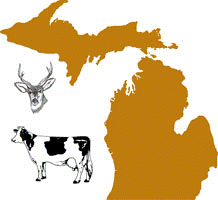Wildlife Disease and Zoonotics
Date of this Version
4-2009
Abstract
Background: The management of many pathogens, which are of concern to humans and their livestock, is complicated by the pathogens’ ability to cross-infect multiple host species, including wildlife. This has major implications for the management of such diseases, since the dynamics of infection are dependent on the rates of both intra- and inter-specific transmission. However, the difficulty of studying transmission networks in free-living populations means that the relative opportunities for intra- versus inter-specific disease transmission have not previously been demonstrated empirically within any wildlife-livestock disease system. Methodology/Principal Findings: Using recently-developed proximity data loggers, we quantify both intra-and interspecific contacts in a wildlife-livestock disease system, using bovine tuberculosis (bTB) in badgers and cattle in the UK as our example. We assess the connectedness of individuals within the networks in order to identify whether there are certain ‘high-risk’ individuals or groups of individuals for disease transmission within and between species. Our results show that contact patterns in both badger and cattle populations vary widely, both between individuals and over time. We recorded only infrequent interactions between badger social groups, although all badgers fitted with data loggers were involved in these inter-group contacts. Contacts between badgers and cattle occurred more frequently than contacts between different badger groups. Moreover, these inter-specific contacts involved those individual cows, which were highly connected within the cattle herd. Conclusions/Significance: This work represents the first continuous time record of wildlife-host contacts for any free-living wildlife-livestock disease system. The results highlight the existence of specific individuals with relatively high contact rates in both livestock and wildlife populations, which have the potential to act as hubs in the spread of disease through complex contact networks. Targeting testing or preventive measures at high-contact groups and individuals within livestock populations would enhance the effectiveness and efficiency of disease management strategies.



Comments
Published in PLoS ONE 4(4): e5016. doi:10.1371/journal.pone.0005016 Copyright 2009 Bohm et al. This is an open-access article distributed under the terms of the Creative Commons Attribution License, which permits unrestricted use, distribution, and reproduction in any medium, provided the original author and source are credited.